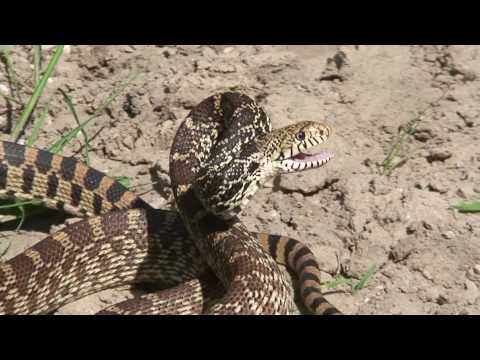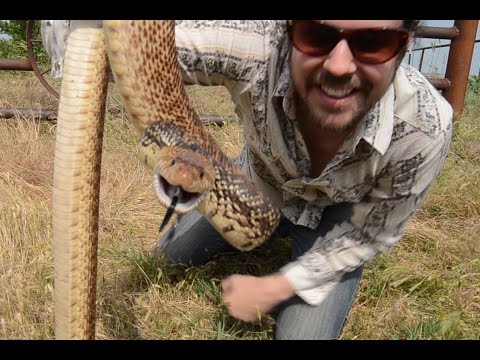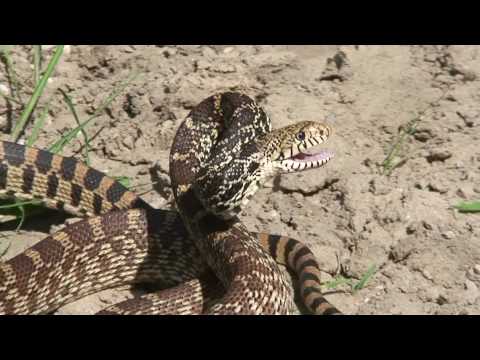Even if you don’t like snakes, most snakes that you encounter in the wild are nothing to write home about. Most are tiny and furtive, quickly taking cover, and slithering through leaf litter and underbrush to get away from you.
However, some snakes are so big, so powerful and so impressive they are genuinely intimidating even for people who aren’t ordinarily afraid of snakes.
The bullsnake is one such snake, common across much of North America: a snake this large will definitely get your attention, but what we need to know is if the bullsnake is venomous and dangerous. Is it?
No, bullsnakes are not venomous, and not truly dangerous to people even though they have a nasty bite.
Bullsnakes are seriously impressive creatures, no doubt about it, and they can be even more calls for concern because they are routinely mixed up with rattlesnakes because of their coloration, and their disturbing tendency to rear up, hiss, and drum their tail just like those infamous, venomous snakes.
But, so long as you know how to positively identify them you don’t have to worry about a bullsnake. I’ll tell you all about them just below.
What Does the Bullsnake Look Like?
Though bullsnakes can vary in color all subspecies have one thing in common, and that is their thick, heavily muscled body, and typically great length.
Many adults are longer than 3 ½ feet (1 meter), and it is far from unheard of for them to top 6 feet (1.8 meters)! These are some of the largest, longest, and strongest native snakes in North America!

But back to the color of bullsnakes. There can be considerable variation in their scales, but most subspecies have a regularly spaced pattern consisting of brown or dark brown patches interspaced with cream and yellow.
The result is a series of peculiar markings that look a little bit like a ball being squeezed at either end, running all along the back and sides of the snake.
The ventral side, or belly, of the snake is typically a pale yellow or off-white color with a checkered pattern of dark brown to black markings along the edges.
Moving forward to the head of the snake, you’ll notice that it is just as thick and impressive as the rest of the body, and the area around the mouth or lips often features dark bars on the upper side.
Similarly, horizontal markings, also dark, usually extend between the eyes and the jaws.

Where are Bullsnakes Found?
Bullsnakes are found throughout the Midwestern United States and somewhat less frequently in the American Southwest and all along the west coast.
Bullsnakes are properly categorized as a subspecies of gopher snake, and that means they too are prairie snakes and so inhabit pasture lands, fields, riverbanks, and any other place that doesn’t have too many trees growing.
That would certainly give you the impression that these snakes are strictly terrestrial, but despite their prodigious size and weight bullsnakes are highly capable climbers.
Bullsnakes usually roam around during the day looking for food, stopping only to warm themselves on rocks, logs, and other convenient perches before retreating underground at night for shelter and warmth.
Notably, bullsnakes, very much like hognose snakes, are capable diggers thanks to their strength, stout skulls, and the protruding scales near their nose.
This combined with their propensity to take over the occupied or unoccupied burrows of other animals means that you will routinely see bullsnakes emerging from underground lairs anywhere in their range.
Are Bullsnakes Venomous?
No. Bullsnakes are constrictors, and non-venomous.
Can the Bullsnake Kill Pets or Domestic Animals?
Yes, they can. Bullsnakes are big reptiles with big appetites, and they have been known to eat multiple smaller animals, bird eggs, and other critters in succession for days at a time.
A bullsnake that gets into your chicken coop will eat multiple chicks or eggs, and their tremendous size and strength mean that even larger chickens, dogs, cats, and other animals could be at risk.
Also, as you might imagine, bullsnakes are quite scary even for larger animals and if one goes near cattle or horses they might break into a panic which could result in an accidental injury to the animals themselves or nearby people.
Will Bullsnakes Attack Humans?
Bullsnakes are not truly aggressive, and prefer to avoid humans but since they are so large and powerful they are also used to getting their way most of the time.
Bullsnakes hunt constantly when they are awake and on the move, and whenever they perceive that a nearby animal is just too large to eat they immediately assume it is a threat.
At this point, the bullsnake will do one of two things: it will either retreat and try to get out of the way like most other snakes, or else it will stand their ground, assume a striking pose, hiss and drum their tail against the ground.
This last behavior is designed to mimic the similarly sized but far more dangerous rattlesnake, and is particularly effective if dry foliage is beneath the tail when they do this.
Sadly, it also results in the relatively harmless bullsnake getting killed when people do, in fact, mistake it for a rattler.
If you do not keep your distance when a bullsnake assumes this defensive posture, it will bite if you come closer, and since they are so long they can bite from a surprising distance. Be careful!
Will a Bullsnake Bite Hurt You?
Absolutely! Bullsnakes are non-venomous, as mentioned, but they are great big snakes with a mouthful of razor-sharp teeth that will cut you wide open if they bite.
Considering how strong they are, a bite from a bullsnake will be significantly worse than a bite from a similar but smaller constrictor.
A bullsnake bite could require stitches, and there’s a high likelihood that the bite will get infected which means that medical attention is a really good idea even if you have positively identified the offending snake as a bullsnake.
Is It Best To Kill Bullsnakes When You Can?
As scary and sometimes troublesome as these snakes can be, it’s generally a bad idea to kill them unless you have no other choice.
Bullsnakes are important predators in every biome where they are encountered, and play a big part in keeping rodents and other small mammal populations under control.
Now, this is a little comfort if you are raising poultry, rabbits, or any similarly sized animals that might end up on a bullsnake’s menu…
If you can positively ID the snake, capture it safely, and then try to relocate it, do it, but if you can’t, then contact a wildlife rehabber or another agency that might come and relocate the animal for you.


